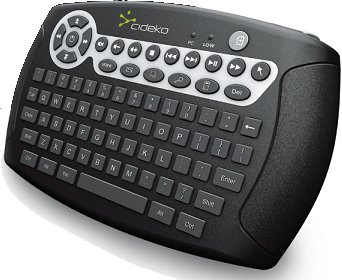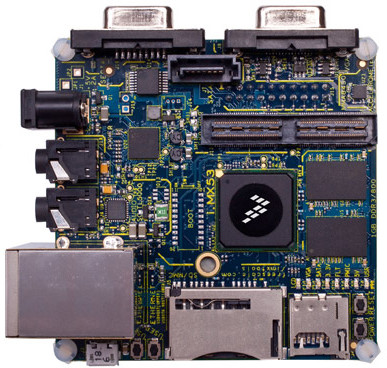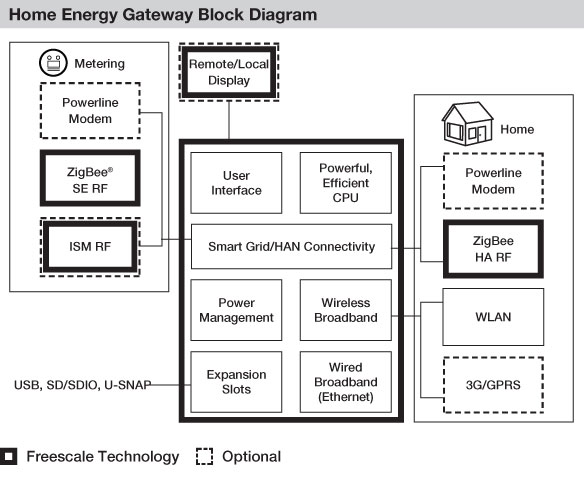Cypress Semiconductors was at Embedded World 2011 exhibiting their PSoC 5 development kits based on ARM Cortex M3 and analog & digital programmable modules. They had different development boards and demos based on PSoC 5: A simple board with PSoC 5, capacitive sensing, radio and accelerometer where they lit up a LED when the board moves (CY8CKIT-014 kit – see below for details). A similar board with a dot-matrix LCD and a potentiometer, where they display the voltage at the Analog input on the LCD. (CY8KIT-010 kit – see below for details). A full development kit with PSoC 5, PSoC 3 and PSoc 5. (CY8KIT-001 kit – see below for details). Several demo of multi-touch and motion sensors capabilities etc.. The development kits are already available (engineering samples), but PSoC 5 will only be mass-produced in Q3 2011 since they are currently qualifying the chip. You can see the development […]
Telechips 8803 based Android Tablet
Mobile Tech, a Hong Kong based company, showcased two Android tablets (8″ and 10″) based on the new Telechips 8803 processor (ARM Cortex A8) running at 1.2GHz that supposedly offers better performance than the first Galaxy Tab. Both devices use an Innolux capacitive touchscreen, the 8″ version has a resolution of 800×600 and the 10″ 1024×768, both have 512MB RAM and 4GB Flash memory, HDMI output, 802.11n Wifi and optionally 3G and a 1.3MP front camera. They plan to support Android 2.3 (Gingerbread) with this version of the hardware for the time being. Honeycomb will need more RAM (at least 1GB) and more time for the porting with Telechips TCC8803. They only expect Android 3.0 to be ready by the end of the year on that platform. The 8″ version is already in mass production, their price target is 300 Euros retail. The 10″ version should be ready in May […]
Android 2.2 Media Player: Cidecko Simple Box AB03
Cidecko, a Taiwanese company, demoed its new Android media player the Cidecko Simple Box AB03 running Android 2.2 on an undisclosed 500 Mhz CPU (Based on this frequency, could it be one of Sigma Designs SMP8650 series, e.g. SMP8653?) at CeBit 2011. They have an innovative remote control (named Air Keyboard AK02d) in the shape of a game controller with a full keyboard, an accelerometer and of gyroscope to control the menu. The set-top box has HDMI, component (YPbPr) and composite video outputs, optical audio output, 2x USB Host, an SD card reader (supports SDHC), an Ethernet port and support Wifi (802.11n) via an external dongle. Although it’s running Android 2.2, note that it does not support full flash, but only Flashlite 9.0. It can support the most popular video codecs including MPEG-2, MPEG-4, H.264/AVC, RMVB and VC-1 and audio codecs such as MPEG, Dolby, DTS.. The retail price of the […]
Android 2.2 IETV Smart Player by Shenzhen Ider Technology
Shenzhen Ider Technology (亿典华科技) showcased two Android 2.2 media player prototypes based on a Samsung ARM Cortex A8 Processor (Probably Samsung SOPC100) at CeBit 2011. They feature an Ethernet port, one or several video output ports(HDMI / Component / Composite), several USB Host ports and can output up to 1080p. The low cost version on have HDMI ouput, whereas the other version has HDMI, component and composite. Both devices support wireless mouse and keyboard and come with a magic remote (wii-like) to control Android. This is interesting to note that whereas other set-top boxes doe not use the Android home as there main menu, those media players do. The low cost version would be around 60 to 80 USD for order larger than 1000 pieces and the higher cost version slightly over 80 USD.
Low Cost Freescale i.MX53 (Cortex A8) Development Board
Possibly inspired by Texas Instruments low cost Beagleboard (OMAP 3 – 129 USD) and Pandaboard (OMAP4 – 179 USD) and the large following in the development community, Freescale announced its own “Quick Start Development Board” based on i.MX53 for a cost of 149 USD. i.MX53 QSD Board Hardware Description Listed Hardware Features of the i.MX53 Quick Start Development Board: Processor i.MX53 1 GHz ARM Cortex-A8 Processor Power management IC 1 GB DDR3 memory Display LVDS connector VGA connector Parallel LCD add-on card (via expansion connector) HDMI add-on card (via expansion connector) Audio SPDIF output via HDMI add-on card Freescale SGTL5000 audio codec Microphone jack Headphone jack Expansion Connector Enables parallel LCD or HDMI output Camera CSI port signals I2C, SSI, SPI signals Connectivity Full-size SD/MMC card slot microSD card slot 7-pin SATA data connector 10/100 Base-T Ethernet port Two High-Speed USB host ports Micro USB device port Debug JTAG connector […]
Databases for Linux Embedded Systems: Berkeley DB and SQLite
Embedded systems often need to use database to store contact information, EPG data and more. Many Linux systems use MySQL, however such a large database management system may not always be appropriate for embedded systems. Hence, there are lightweight database management systems implementation that are especially suited to embedded systems by their binary footprint, memory footprint and CPU requirements. If you want to develop in C in Linux and your requirement is to have no (or little) license to pay in your application, you could consider Oracle Berkeley DB or SQLite among others. Oracle Berkeley DB (previously Sleepycat Berkeley DB) is described as follows: Berkeley DB enables the development of custom data management solutions, without the overhead traditionally associated with such custom projects. Berkeley DB provides a collection of well-proven building-block technologies that can be configured to address any application need from the hand-held device to the datacenter, from a […]
Freescale Home Energy Gateway Reference Platform
I’ve previously introduced Atmel / Mentor Embedded smart grid solutions, specifically Atmel In-Home Display hardware with Mentor’s Inflexion User Interface. Today, I’ll present Freescale Home Energy Gateway Reference Platform based on i.MX283 ARM 9 MCU, MC13224V Zigbee IC, 9S08QE32 MCU & MC34726 Regulator and running Windows® Embedded Compact 7. The home energy gateway is the interface between the utility-controlled smart grid and energy-consuming in-house objects. The graphical user interface (GUI) has been design with Silverlight. Functions of the Home Energy Gateway Collect real-time energy consumption from smart meter and power consumption data from various in-house objects Control activation/deactivation of home appliances Generate dashboard to provide feedback about power usage Provide control menus to control appliances Provide a ubiquitous link to the broadband Internet Freescale home energy gateway solutions allow every point of the smart home to be connected and controlled from a central point, enabling power efficiency and energy optimization. […]
Android C/C++ development with Android Native SDK
HyperDevBox is a Japanese based software development company, developing games for Android. They are presenting their new Android game called “Spectral Souls”, the first tactical RPG game for Android. The interesting part is that this Android gamewas not developped with Java, but only using C/C++ programming with Android Native SDK (NDK) (Currently revision 5). Using the NDK means you’ll have to adapt your software to several hardware platform contrary to java development. They now only support Qualcomm and PowerVR GPU for now, and they are working on supporting NVidia Tegra platform and other upcoming GPU. The advantage of native code is a potential performance improvement and code re-use if you have already applications developed in C/C++, the inconvenience is that more work is need to support different hardware. Currently the NDK is only available for ARM platforms (ARMv5TE andARMv7-A), future releases will support x86 instructions. The video below is an […]










